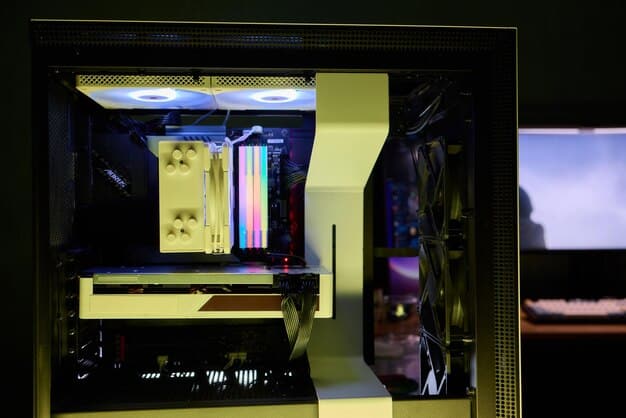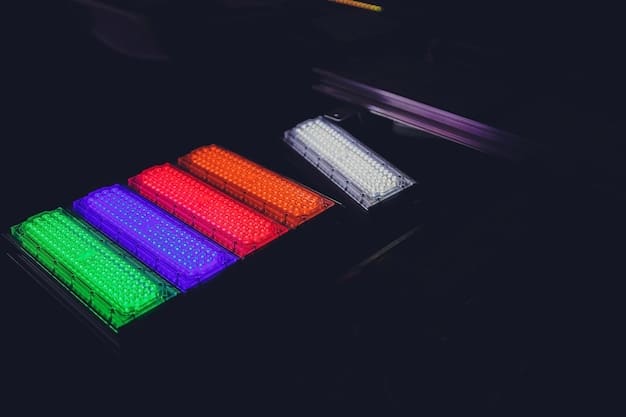Ray Tracing in 2025: Will Your PC Handle the Next-Gen Games?

Preparing your PC for the ray tracing revolution in 2025’s biggest PC games involves understanding the hardware demands, including a powerful graphics card and sufficient processing power, to ensure a smooth and visually stunning gaming experience.
Is your PC ready to handle the stunning visuals and immersive experiences promised by the ray tracing revolution in 2025’s biggest PC games? With the next generation of titles pushing the boundaries of graphical fidelity, now is the time to assess your hardware and ensure you’re not left behind.
Understanding Ray Tracing: The Future of Gaming Graphics
Ray tracing is poised to redefine how we experience video games, offering a level of realism and immersion previously unattainable. But what exactly is ray tracing, and why is it such a game-changer for PC gaming?
It involves simulating the physical behavior of light, tracing its path as it interacts with objects in a virtual scene. This creates incredibly realistic lighting, reflections, and shadows, adding depth and nuance to the game world.
The Visual Benefits of Ray Tracing
Ray tracing brings several key visual improvements to games. Dynamic reflections, more realistic shadows and light scattering help improve the visual expereince:
- Realistic Lighting: See light realistically bounce between objects, creating natural and immersive environments.
- Dynamic Reflections: Experience reflections that accurately mirror the surrounding scene, enhancing realism.
- Improved Shadows: Enjoy shadows with soft edges and accurate light blockage, adding depth and dimension.
Ray tracing is no longer a niche technology. As 2025 approaches, the biggest PC games are expected to fully embrace and leverage ray tracing capabilities.

Key Hardware Components for Ray Tracing in 2025
To fully enjoy ray tracing in 2025’s games, your PC will need specific hardware components capable of handling the intense computational demands. Here’s a breakdown of the essential components.
With optimized settings and reasonable expectations, it is still possible to enjoy the titles with a lower configuration. However the experience will not be the same.
Graphics Card (GPU): The Ray Tracing Workhorse
It is safe to say the graphics card will bear the brunt of the workload. The GPU is the most crucial component for ray tracing, and you’ll need a modern, high-end card to achieve smooth frame rates and breathtaking visuals.
- Nvidia GeForce RTX Series: This series features dedicated ray tracing cores (RT Cores) and AI-powered Tensor Cores, providing the best performance for ray tracing tasks. Aim for an RTX 4070 or higher for a good balance of performance and price.
- AMD Radeon RX Series: AMD’s RX series cards also support ray tracing, leveraging their own ray accelerators. The RX 7800 XT or higher will deliver solid ray tracing performance.
- Consider VRAM: Ensure your GPU has sufficient VRAM (Video RAM), ideally 12GB or more, to handle the increased memory demands of ray-traced games.
Choosing the right GPU is a considerable investment but can extend the life of your device, and allow you to play at higher settings, ray tracing included.
Processors (CPU): Ensuring Smooth Gameplay with Ray Tracing
The CPU is also important and contributes to the overall gaming experience, even when ray tracing is primarily handled by the GPU. A powerful CPU ensures smooth gameplay, prevents bottlenecks, and handles other background tasks efficiently.
While the GPU handles the intensive ray tracing calculations, the CPU manages game logic, AI, physics, and other tasks that contribute to the overall gaming experience.
Recommended CPU Specifications for Ray Tracing
Although the CPU is not as important as the GPU in ray tracing, it should not be neglected. Here are some options to consider:
- Intel Core i7/i9 (12th Gen or Newer): These CPUs provide excellent gaming performance, with multiple cores and high clock speeds to handle demanding tasks.
- AMD Ryzen 7/9 (5000 Series or Newer): AMD’s Ryzen CPUs offer strong multi-core performance, making them well-suited for gaming and other CPU-intensive applications.
- Core Count: Aim for at least 8 cores to ensure smooth performance in modern games that utilize multiple threads.
The CPU, when paired with the right GPU generates a faster render, and keeps the game running smoothly even when ray tracing is enabled.

RAM and Storage: Optimizing Performance for Ray-Traced Games
Beyond the GPU and CPU, RAM and storage play crucial roles in ensuring smooth and responsive gameplay with ray tracing. Insufficient RAM can lead to stuttering and slowdowns, while slow storage can cause long loading times and texture pop-in.
Having sufficient RAM and fast storage is critical for modern gaming, especially when dealing with the increased demands of ray tracing. Here’s what you need to consider.
RAM Requirements for Ray Tracing in 2025
One can easily underestimate the impact of RAM to the performance in a game. Take the following into consideration:
Minimum: 16GB DDR4 is the bare minimum for modern games, but it might not be sufficient for ray tracing at higher settings.
Recommended: 32GB DDR4 or DDR5 is ideal for a smooth experience with ray tracing enabled, allowing the game to load and manage assets efficiently.
Storage Solutions: SSDs vs. HDDs
HDDs (Hard Disk Drives) are the traditional storage solution and are mechanically slower than SSDs. Here is why one is now preferred:
SSDs (Solid State Drives): SSDs offer significantly faster read and write speeds compared to HDDs, reducing loading times and improving overall system responsiveness.
NVMe SSDs: NVMe SSDs provide even faster performance than traditional SATA SSDs, utilizing the NVMe protocol to communicate directly with the motherboard via the PCIe interface. This results in incredibly fast loading times and seamless asset streaming.
Investing in fast RAM and SSD/NVMe storage will significantly enhance your gaming experience, especially when combined with ray tracing.
Software and Drivers: Keeping Your System Up-to-Date
Having the right hardware is only half the battle. Keeping your software and drivers up-to-date is equally crucial for optimal performance and compatibility with ray-traced games. Outdated drivers can lead to performance issues, visual glitches, and even system instability.
Software and drivers act as an intermediary between your hardware and the games you play. Updated it is paramount.
Importance of Updated Graphics Drivers
It is important to recognize that, similar to the hardware, if the drivers are not the correct one, it will limit the ray tracing capacity.
- Performance Optimizations: Driver updates often include performance optimizations specifically tailored for the latest games and ray tracing features. These optimizations can significantly improve frame rates and reduce stuttering.
- Bug Fixes: Driver updates address bugs and glitches that can cause visual artifacts, crashes, or other issues with ray tracing.
- Compatibility: Newer drivers ensure compatibility with the latest ray tracing APIs and game engines, allowing you to take full advantage of the technology.
Always check the manufacturer’s website for recent news. They provide a more comprehensive explanation about it.
Anticipated Ray Tracing Games in 2025
As we approach 2025, numerous highly anticipated PC games are expected to feature cutting-edge ray tracing implementations. These titles will push the boundaries of graphical fidelity and offer stunningly immersive gaming experiences.
2025 is poised to be a watershed year for ray tracing in PC gaming. Here are a few of the most anticipated titles that are expected to showcase this technology.
- AAA Titles: Keep an eye on upcoming AAA releases from major studios, as they are likely to feature advanced ray tracing implementations. This category includes sequels to established franchises, new IPs with high production values, and games developed using cutting-edge game engines.
- Cyberpunk 2077 (Further Enhanced Edition): It is very plausible this game will receive another update, fully utilizing ray tracing and showing its capacity.
- Indie Games with Ray Tracing: Some indie games are also experimenting with ray tracing, pushing the boundaries of visual fidelity with limited resources. Keep an eye out for these hidden gems, as they could offer unique and innovative ray tracing implementations.
With cutting-edge software and appropriate components, these games will perform as expected and bring the desired immersion.
| Key Point | Brief Description |
|---|---|
| 💡 GPU Upgrade | Invest in a modern GPU (RTX 4070 or RX 7800 XT and higher) for optimal ray tracing performance. |
| 🧠 CPU Considerations | Ensure your CPU (Intel i7/i9 or AMD Ryzen 7/9) can handle game logic, AI and physics efficiently. |
| 💽 RAM & Storage Needs | Upgrade to 32GB RAM and use an NVMe SSD for faster loading times and smoother gameplay. |
| ⚙️ Software & Drivers | Keep your graphics drivers updated for performance optimizations and compatibility. |
FAQ
▼
Ray tracing simulates light behavior for realistic graphics in games, greatly enhancing visual fidelity and bringing a new level of immersion.
▼
Minimum specs include an RTX 3060 or RX 6700 XT GPU, 16GB RAM, and a fast SSD for a basic ray tracing experience.
▼
While not mandatory, a monitor with high resolution and refresh rate can fully showcase the visual improvements from ray tracing.
▼
Ray tracing can generally be enabled only on titles that specifically support the feature, and it could affect the games performance.
▼
Aim for at least 8GB of VRAM, but 12GB or higher is recommended for higher resolutions and detail settings with ray tracing.
Conclusion
As 2025 approaches, preparing your PC for the anticipated ray tracing revolution in gaming involves careful consideration of your graphics card, processor, RAM, and storage. By upgrading these key components and keeping your software up-to-date, by the time these games get released you are on the front lines of game immersion.





